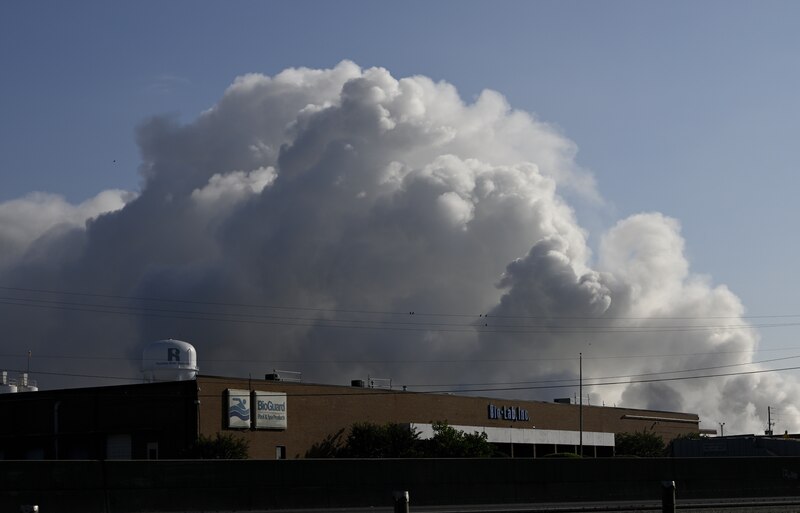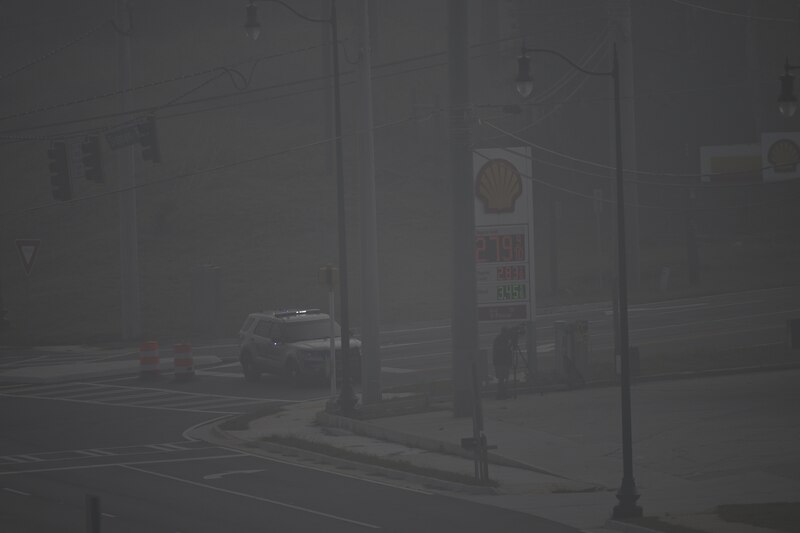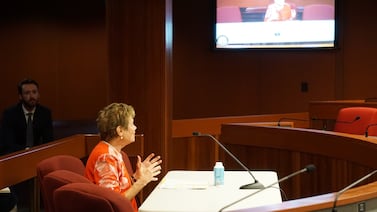Public health, explained: Sign up to receive Healthbeat’s free Atlanta newsletter here.
The people of Conyers are demanding the BioLab chemical plant answer their questions, pay restitution, and leave town nearly a month after smoke from a fire shuttered schools and brought daily life to a standstill.
Rockdale County says it will file a federal lawsuit. U.S. Sen. Raphael Warnock has demanded a detailed accounting of the accident from BioLab and its plans to help residents recover.
But questions remain about what steps local and state regulators took to prevent a fire at a facility with a track record of environmental violations, including similar accidents in 2020.
While it’s not entirely clear how the fire started, clean-up this time involved removing 4 million pounds of trichlor, or trichloroisocyanuric acid, a swimming pool disinfectant, Rockdale County Fire Rescue Chief Marian McDaniel said.
“The federal lawsuit is a step in the right direction, but we still have more questions than answers for BioLab and Rockdale County government,” said Madelyne Reece, a resident who runs a Facebook group opposing the facility.
The patchwork response to the accident that sent a plume of chemical smoke over parts of metro Atlanta has exposed shortfalls in emergency response planning, environmental enforcement and public health coordination and communication.
BioLab defends its safety record
BioLab, which manufactures swimming pool and spa products, has had a facility in Conyers since 1973. It employs about 350 people.
State, local, and federal laws govern how companies like BioLab handle dangerous chemicals.
But much of the responsibility for safety rests with the company and its day-to-day practices, experts told Healthbeat.
Companies and institutions working with dangerous chemicals need “failsafe” systems and a “safety culture,” said Sankar Nair, a professor at Georgia Tech who teaches chemical safety.
“Generally, it is very well known in the chemical safety field that accidents like this don’t just occur randomly due to bad luck,” Nair said. “Usually there’s a pattern of shortcomings in multiple safety aspects.”
The Conyers BioLab facility has had at least three previous fires: one in May 2004 and two in September 2020. The company’s facility in Westlake, Louisiana, also caught fire in August 2020, prompting a lengthy investigation and report from the federal Chemical Safety Board.
“Accidents don’t just happen,” said safety consultant Andrew Gondzur, adding their causes can be identified and eliminated with effective planning.
Safety should be not just a priority but a “a value that can’t be subordinated or discounted or reorganized,” Gondzur said. “It’s not a priority that could be shuffled [to] follow production and profit and quality.”
Environmental lawyers agree.
“This facility has been plagued by repeated failures to comply with environmental laws intended to safeguard the proper handling, storage, and use of the chemicals entrusted to their care,” said Christopher Bowers, an environmental attorney and partner at Stacey Evans Law.
“Where there’s smoke, there’s fire, and we’re seeing that play out in Rockdale County,” he said.
BioLab has defended its safety record.
Healthbeat asked the company what it did to rectify safety concerns following the 2020 fires and the resulting 121-page Chemical Safety Board investigation report. That report recommended, among many other things, that BioLab properly maintain and test its fire protection systems.
“Over the years, our company has been rigorous about actioning enhancements to our facilities, policies, and practices,” spokesperson Daniel Hoadley said in an email. He said the Conyers facility has implemented upgrades to safety equipment, enhanced emergency response protocols, and broad training for employees.
Hoadley said the fire in Louisiana resulted from hurricane damage from Hurricane Laura. At the Conyers facility, the company conducted “periodic tests and evaluations of our fire protection systems based on industry standards, as well as walk-throughs with the local fire department.”
He declined repeated requests for a list of dates of fire department walk-throughs.
Local government lacked response plans
Rockdale County officials defended their actions to prevent and plan for fires. But county representatives would not provide a list of dates when the fire department held walk-throughs or made other visits to the facility.
A county committee that could have helped plan for such an accident was disbanded after the Covid outbreak, said Melisa Mims, the county’s public relations director.
Local Emergency Planning Committees are, under a 1986 federal law, supposed to develop emergency response plans, review them annually and provide the public with information about chemicals present in the community.
The committees are meant to include local officials – police, fire, and public health professionals – as well as representatives from local facilities, community groups, and the media.
But shortly after the Rockdale County Commission created its committee in September 2018, it was disbanded. Its last meeting was in November 2019.
“I’ve never heard of an LEPC being formed and then disbanded,” said Donald Stack, a longtime Georgia environmental attorney with nearly four decades of experience.
Local emergency planning committees are important because there are thousands of chemical emergencies each year, said Gondzur, who sits on the St. Louis LEPC.
The committees bring together community members who are “working toward a common goal of hazardous chemical planning and safe response,” Gondzur said. “A broad spectrum of members is essential for representation of the various points of view necessary to formulate a truly workable emergency plan.”
Even though Rockdale disbanded its LEPC, the county did take steps to prepare for a fire, Mims said.
“Training, drills, and safety debriefs have been conducted with departments, stakeholders, partner agencies, and public safety agencies,” she said. “The county emergency management agency meetings were attended by members of county departments and agencies, organized support forces, businesses, and public safety agencies.”

The county has not yet responded to an open records request from Healthbeat for a “pre-plan” document that lays out plans for fighting a fire at BioLab, but it did provide a copy of its Emergency Operations Plan.
That document is not dated. Board of Commissioners representative Pattie Pearson said, “It has been awhile since the plan was updated, and I do know that they are in the process of updating that now.”
Local emergency planning committees do not have the ability to enforce safety regulations, said Timothy Gablehouse, an attorney who serves on the board of the National Association of SARA Title III Program Officials, which includes first-responders and emergency planning officials.
But they can be helpful in making sure diverse voices are included in emergency planning and that local citizens know about risks in their community.
“Is there an emergency planning process in the community that does an adequate job of talking to the public, especially people that are protected by the Civil Rights Act, or people that are protected by the Americans with Disabilities Act?” Gablehouse said.
“You frequently will have a slightly better outcome if members of the public are aware, educated and can take actions to protect themselves.”
Lack of planning reflected in unclear messaging
The public health messaging around the fire was unclear, many residents said.
Officials said at press conferences that exposure to the burning chemicals could cause short-term irritation like cough or a burning throat, but they would not cause any long-term effects.
“After an acute exposure to chlorine type gases such as this, any deficits in pulmonary function generally return to baseline within about one to two weeks,” Dr. Lynn Paxton, interim district health director for Gwinnett, Newton and Rockdale counties, said at an Oct. 17 press conference.
Hans Plugge, an independent toxicologist who heads Safer Chemical Analytics, a consulting firm, and other air-quality experts agreed with that statement.
But residents aren’t convinced — likely because they experienced a traumatic event, Plugge said.
“It is anxiety provoking to see a big black cloud coming at your house,” Plugge said, so it’s understandable people are worried about their health and attributing health impacts to the fire that the science may not support.
“I want to see a complete list of all chemicals we’ve been exposed to, not just the two you’d like to throw out every day. I want full comprehensive testing on the water, air, soil, and debris based on that full list, so that we can finally, as a community, start to make personal decisions about our health, having the full knowledge,” Reece said at a rally on Saturday demanding the BioLab plant be shut down.
“We were told that the chemicals aren‘t hazardous, and yet my phone was buzzing all, every day, ’shelter in place.’ Why am I sheltering in place if the chemicals aren’t happening?” resident Brian Jenkins said.
Local leaders needed to do a better job explaining what happened and explaining their decisions, Plugge said.
“This is a message that has to be done multiple times, has to be done in different ways, and it can’t just be a press release,” he said.
“Somebody needs to sit down and actually do that discussion on hazard and risk assessment,” Plugge said, adding that public concerns might have been better managed if people were encouraged to ask questions. “Public health officials are deadly afraid of standing in front of the public once it’s riled up.”
Paxton was critical of the emergency response.
During a Fulton County Board of Health meeting on Wednesday, she cited two major mistakes in the response to the fire:
It was difficult to know who was in charge for the first several days, Paxton said. And it took at least two days to set up a joint information center to manage communication with the media and public.
State officials inspected plant days before fire
The state government is also responsible for many aspects of environmental regulation, said Patrick Anderson, an attorney at the Southern Environmental Law Center, including enforcing the federal Clean Air Act.
Georgia’s Environmental Protection Division has inspected and issued compliance actions to the BioLab facility in the past, EPA records show.
For example, the Georgia EPD completed what’s called a “full compliance evaluation” under the Clean Air Act on Sept. 23, six days before the fire.
The facility also faced two informal enforcement actions under the Clean Air Act in April 2022 and May 2024.
BioLab received “written informal” enforcement actions in February 2024 from the state for violations of a federal law that deals with the disposal of hazardous waste, called the Resource Conservation and Recovery Act.
And the company was fined $1,000 for failing to pay its 2020 Air Quality Act permit fees.

Environmental attorneys and advocates say the EPD is stretched thin; it does not have enough funding or staff to adequately enforce the law.
“Agencies like EPD are frequent targets for budget and staff cuts, but events like this show why it is vital that EPD have the necessary resources to conduct frequent inspections and bring corrective action to prevent these kinds of disasters,” Anderson said.
Looking ahead, the agency could take broad enforcement actions against BioLab, even canceling the company’s air permits, which would effectively shut down the facility, Anderson said.
“There’s a provision under the Georgia rules that basically says the director of EPD has authority to implement whatever measures he deems necessary to protect the public health,” Anderson said.
Meanwhile, Conyers residents are urging Gov. Brian Kemp to get involved or even declare a state of emergency.
“I want to know why the governor has not been out here doing anything,” Angela Ausburn said at the weekend rally.
Kemp made a brief statement about the fire but has not visited the town. Other community members said they wanted to rally outside the Governor’s Mansion.
“I would just refer you to EPD or EPA on any enforcement actions. … If there are violations, that’s what they do every day. They don’t need direction from me on that. I tell them to do their job, and that’s what they do,” Kemp said on Oct. 3.
“The state has served in a supportive role to the unified command led by the EPA and Rockdale County government,” Kemp spokesperson Garrison Douglas said this week.
Federal investigation could take years
The U.S. Chemical Safety and Hazard Investigation Board is investigating the accident, according to a press release on its website.
But its report could take years; the report on the 2020 fires was published nearly three years later. And the board’s recommendations lack any enforcement power.
For example, the agency has been recommending since 2002 that certain chemicals, including the reactive substances like the one at issue in the BioLab fires, be added to a federal list requiring additional risk-management planning. But the EPA has never adopted that regulation, Anderson said.
Such a regulation might have forced BioLab to develop a risk management plan to prevent and deal with accidental releases of dangerous chemicals, he said.
Rebecca Grapevine is a reporter covering public health in Atlanta for Healthbeat. Contact Rebecca at rgrapevine@healthbeat.org. Healthbeat reporter Allen Siegler contributed to this report.






